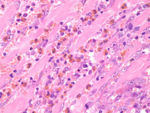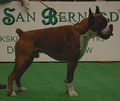Difference between revisions of "Enteritis, Eosinophilic"
| (17 intermediate revisions by 5 users not shown) | |||
| Line 1: | Line 1: | ||
| − | + | [[Image:eosinophilic_enteritis.jpg|thumb|right|150px|Histology of Eosinophilic enteritis in the horse <sup>©Susan Rhind, University of Edinburgh</sup>]] | |
| − | + | ==Introduction== | |
| − | + | Eosinophilic enteritis (EE) is the second most common form of [[Inflammatory Bowel Disease#Treatment|IBD]], characterised by a mixed, but predominantly eosiphilic, mucosal inflammatory infiltration. EGE may be limited to the small intestine or it may affect other areas of the gastrointestinal tract such as stomach or colon; the condition is cetegorised into focal or diffuse EE. | |
| − | |||
| + | An eosinophilic infiltrate may indicate a diet-induced, type 1 hypersensitivity. However, most dogs do not respond to a purely exclusion diet. Endoparasitism should also be excluded prior to immunosuppressive therapy for EE. | ||
==Signalment== | ==Signalment== | ||
| − | + | Focal EE is a disease of young dogs, which can be associated with [[Toxocara canis|''Toxocara canis'']] infection. Pin-head sized white nodules can be seen under the serosa in the bowel, consisting of eosinophils, and occasionally macrophages, plasma cells and [[Toxocara canis|''Toxocara'']] larvae. | |
| − | |||
| − | |||
| − | |||
| − | |||
| − | |||
| + | The diffuse form of EE is seen in the dog, cat and horse; it is described as idiopathic but the aetiology has been suggested to be a hypersensitivity reaction. In this form of the condition, recurrent episodes of diarrhoea with tissue and circulatory eosinophilia occurs, with a heavy infiltrate of eosinophils present histologically in all layers of the stomach and intestines. | ||
| − | + | There is a predilection for diffuse EE in: | |
| − | ''' | + | <gallery> |
| + | Image:Boxer.jpg|'''Boxer'''<p><small>( © Lilly M WikiMedia Commons)</small> | ||
| + | Image:GermanShep.jpg|'''German Shepherd (Alsatian)'''<p><small>( © Ellen Levy Finch WikiMedia Commons)</small> | ||
| + | Image:Dobermann.jpg|'''Dobermann'''<p><small>( © John Adams WikiMedia Commons)</small> | ||
| + | </gallery> | ||
| − | + | ==Clinical Signs== | |
| − | |||
| − | |||
| − | |||
*Vomiting | *Vomiting | ||
| − | *Diarrhoea; small intestinal is more common | + | *Diarrhoea; small intestinal is more common with haematoemesis or malena, and/or haematochezia; EGE is associated with mucosal erosion or ulceration |
| − | |||
*Protein-losing enteropathy in severe cases | *Protein-losing enteropathy in severe cases | ||
| − | *Hypoproteinaemia in severe | + | *Hypoproteinaemia in severe cases |
| + | ==Laboratory Tests== | ||
| + | Haemotology reveals an anaemia if gastrointestinal haemorrhage is severe. Eosinophilia is not always present and even when seen it is not pathogneumonic for EE. Panhypoproteinaemia can be found secoondary to concurrent protein-losing enteropathy | ||
| − | + | ==Diagnostic Imaging== | |
| − | + | Endoscopically, linear ulcers within the duodenal mucosa may be seen grossly. | |
| − | |||
| − | |||
| − | |||
| − | |||
| − | |||
| − | |||
| − | |||
| − | |||
| − | |||
| − | |||
| − | |||
| − | |||
| − | |||
| − | |||
| − | |||
| − | |||
| − | |||
===Histopathology=== | ===Histopathology=== | ||
| Line 52: | Line 33: | ||
==Treatment== | ==Treatment== | ||
| − | + | Anti-parasiticide (Fenbendazole) treatment may be given due to the possible endoparasitism or dietary sensitivity. Dietary modification is required with a change to a hypoallergenic diet. | |
| − | + | Immunosuppressive therapy may also be required. | |
| − | |||
| − | |||
| − | |||
| − | |||
| − | |||
| − | |||
==Prognosis== | ==Prognosis== | ||
Guarded if the initial response to treatment is poor. Good if the underlying cause is detected and successfully treated. | Guarded if the initial response to treatment is poor. Good if the underlying cause is detected and successfully treated. | ||
| − | |||
==References== | ==References== | ||
| Line 69: | Line 43: | ||
*Hall, E.J, Simpson, J.W. and Williams, D.A. (2005) '''BSAVA Manual of Canine and Feline Gastroenterology (2nd Edition)''' ''BSAVA'' | *Hall, E.J, Simpson, J.W. and Williams, D.A. (2005) '''BSAVA Manual of Canine and Feline Gastroenterology (2nd Edition)''' ''BSAVA'' | ||
*Nelson, R.W. and Couto, C.G. (2009) '''Small Animal Internal Medicine (Fourth Edition)''' ''Mosby Elsevier''. | *Nelson, R.W. and Couto, C.G. (2009) '''Small Animal Internal Medicine (Fourth Edition)''' ''Mosby Elsevier''. | ||
| + | |||
| + | {{Learning | ||
| + | |Vetstream = [https://www.vetstream.com/canis/Content/Disease/dis01035.asp, Canine eosinophillic enteritis] | ||
| + | }} | ||
| + | |||
| + | |||
| + | [[Category:Intestinal Diseases - Dog]][[Category:Intestine_-_Inflammatory_Pathology_by_Type]] | ||
| + | [[Category:To Do - Clinical]] | ||
Latest revision as of 18:52, 20 March 2016
Introduction
Eosinophilic enteritis (EE) is the second most common form of IBD, characterised by a mixed, but predominantly eosiphilic, mucosal inflammatory infiltration. EGE may be limited to the small intestine or it may affect other areas of the gastrointestinal tract such as stomach or colon; the condition is cetegorised into focal or diffuse EE.
An eosinophilic infiltrate may indicate a diet-induced, type 1 hypersensitivity. However, most dogs do not respond to a purely exclusion diet. Endoparasitism should also be excluded prior to immunosuppressive therapy for EE.
Signalment
Focal EE is a disease of young dogs, which can be associated with Toxocara canis infection. Pin-head sized white nodules can be seen under the serosa in the bowel, consisting of eosinophils, and occasionally macrophages, plasma cells and Toxocara larvae.
The diffuse form of EE is seen in the dog, cat and horse; it is described as idiopathic but the aetiology has been suggested to be a hypersensitivity reaction. In this form of the condition, recurrent episodes of diarrhoea with tissue and circulatory eosinophilia occurs, with a heavy infiltrate of eosinophils present histologically in all layers of the stomach and intestines.
There is a predilection for diffuse EE in:
Clinical Signs
- Vomiting
- Diarrhoea; small intestinal is more common with haematoemesis or malena, and/or haematochezia; EGE is associated with mucosal erosion or ulceration
- Protein-losing enteropathy in severe cases
- Hypoproteinaemia in severe cases
Laboratory Tests
Haemotology reveals an anaemia if gastrointestinal haemorrhage is severe. Eosinophilia is not always present and even when seen it is not pathogneumonic for EE. Panhypoproteinaemia can be found secoondary to concurrent protein-losing enteropathy
Diagnostic Imaging
Endoscopically, linear ulcers within the duodenal mucosa may be seen grossly.
Histopathology
Biopsy is required for a definitive diagnosis.
Treatment
Anti-parasiticide (Fenbendazole) treatment may be given due to the possible endoparasitism or dietary sensitivity. Dietary modification is required with a change to a hypoallergenic diet. Immunosuppressive therapy may also be required.
Prognosis
Guarded if the initial response to treatment is poor. Good if the underlying cause is detected and successfully treated.
References
- Ettinger, S.J. and Feldman, E. C. (2000) Textbook of Veterinary Internal Medicine Diseases of the Dog and Cat Volume 2 (Fifth Edition) W.B. Saunders Company.
- Hall, E.J, Simpson, J.W. and Williams, D.A. (2005) BSAVA Manual of Canine and Feline Gastroenterology (2nd Edition) BSAVA
- Nelson, R.W. and Couto, C.G. (2009) Small Animal Internal Medicine (Fourth Edition) Mosby Elsevier.
| Enteritis, Eosinophilic Learning Resources | |
|---|---|
To reach the Vetstream content, please select |
Canis, Felis, Lapis or Equis |



